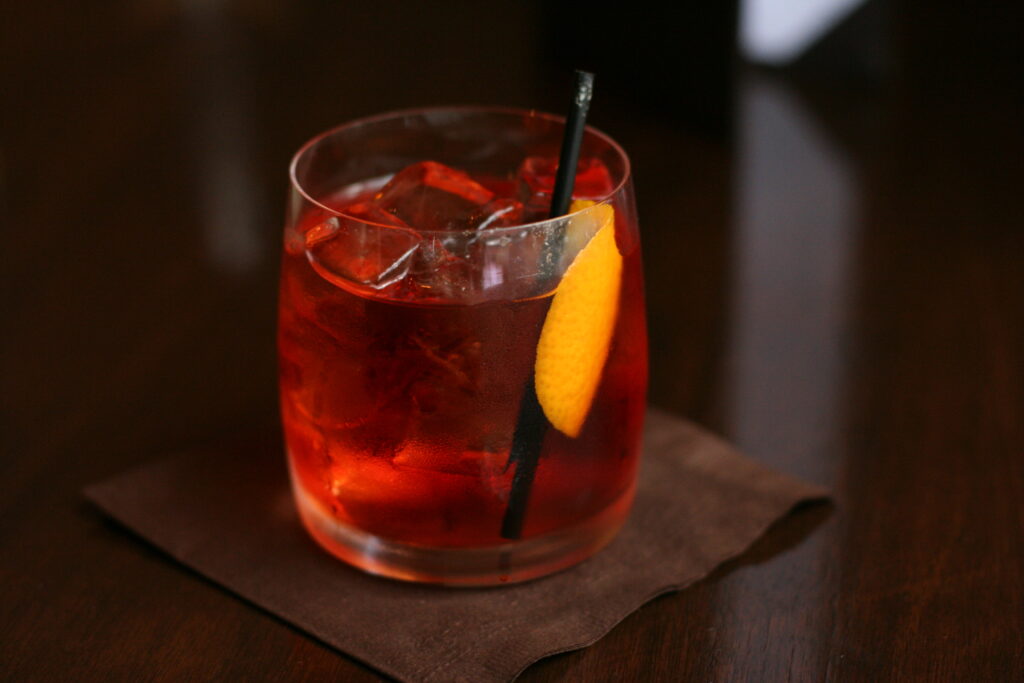
It was probably an otherwise normal June day in Florence. Fosco Scarselli was tending bar at the Caffe Casoni on Via Tornabuono. It may have been aperitivo hour, and the place was lively with people who had just finished work. They were sipping aperitivos meant to open up their appetites for the upcoming meals of the evening. Assisting this gustatorial preparation were dishes of small nibbles. Crostini topped with savory chicken liver pâté (crostini di fegatini), tomato and basil (crostini al pomodoro e basilico), or omelettes called frittatas with vegetables, cheese, or the leftover meats from the day before. There may have been Panzanella, a fresh salad, or little pizzas called pizettes, topped with cheese, olives, or anchovies. Or maybe beef or pork meatballs called polpetttine, which were skewered with toothpicks. Among many others, these whetted the appetite of the diners at the Caffe Casoni.
As the diners sipped and reveled in the day’s work being over and its treats just beginning, a man walked through the door. He was well-known, tough, manly, the subject of local gossip. Just like today, he came into the café often and ordered a cocktail, apparently something he could do up to forty times a day. Count Camillo Negroni ordered a very popular drink called the Americano, which was equal parts Campari and vermouth and topped with soda water. Then, before Mr. Scarselli could lift the Campari off the shelf or hoist his vermouth, the count edited his order.
“Fortify it with gin instead of soda water.”
By all accounts (and there aren’t many), Count Camillo Negroni was sort of a badass. He was born into an elite family that had an adventurous streak in them. They were always going off to find wars or expeditions that would lead to them being either honored in some foreign country or dead or, as sort of a silver lining to a bad situation, both at the same time. In the late 1860s, this particular Negroni had gone off to the United States in search of his own adventure. There – traveling from New York and through the west – he had made a name for himself as a partier, a gambler, and a rodeo cowboy. He made and lost fortunes. He spoke with western accented English and used words like ‘Hombre’ and ‘vittles’. Basically he stepped out of the pages of a Larry McMurtry novel right before he gets skinned alive by Comanches. But that didn’t happen on that June day in 1919. That day, he made cocktail history.
Cocktails have a long history. The ancient Greeks, Romans and Chinese fortified wine with herbs and botanicals. Medieval monks in France, Italy, Spain and Holland developed herbal remedies by infusing botanicals, fruit and herbs infused with alcohol and water, meant to improve the wellbeing of the body and spirit. Aqua Vitae, Chartreuse, Elixir Salutis, Aqua Mirabilis are all herbal medicine boozes that are precursors of the cocktail. In the 18th century the Americans found that drinking rum on its own ends up with them making romantic passes at their neighbor’s horses and murdering the neighbors. So they added water or juice to it, later they’d add coca cola (which was filled with cocaine, which made the horse romance much more likely). The French started adding water to Absinthe to lessen the possibility of blowing their brains out or lopping off their ears. Spoiler: didn’t always work.
And then there were the Italians. In the late 18th century, we see the emergence of northern Italy’s café culture in the Piedmont region of Italy, especially Turin. Turin’s cafe culture was booming and in 1786 the creation of vermouth is a game changer. Though vermouth-adjacent concoctions had been curing people of stomach ailments and bad personalities for centuries, now it’s bottled and drank as a cocktail. In the 1860s, Gaspari Campari in Milan invented a bitter, bright red alcohol called Campari. He added this to vermouth and served it as the Milano-Torino (equal parts Campari and vermouth and called thus because of the founding locations of each. Mankind wouldn’t begin creatively naming cocktails for a few years and wouldn’t stop until it got out of hand (I’m looking at you, A Long Comfortable Screw Against A Wall). In the late 19th century, the Milano-Torino was especially enjoyed by American tourists and thus the name was changed to the Americano. Just as a large coffee would be called an Americano after World War II for the American soldiers who sought something more voluminous akin to the drip coffee in the US. They still call it that in Europe and ordering one still – 80 years later – elicits an eye roll and a whispered epithet. Though, the rolls given the M-1 wielding American GIs who’d just liberated the city were not eye but rather in the hay.
When the Italians found alcohol they used it the same way they use everything – to make life as enjoyable as possible. Italian drinking and eating culture places emphasis on balance, time, and a mellow, relaxed, slow enjoyment of both food and drink. Aperitivo hour is when the first cocktails of the late afternoon are enjoyed alongside small meals. Both are meant to awaken the appetite for the delights of the evening’s upcoming larger meals and wines. For this reason, the cocktails are on the weaker side, and usually contain bitters because they are believed to open the appetite. The Americano, the Spritz Veneziano, and the Aperol Spritz (created in Padua around the same time Negroni made his modification) fit perfectly well into Italian aperitivo culture. The food is also on the small side, crostini, small pizzas, salads, olives. Like most things Italian, it has its roots in Ancient Rome when diners would tuck into small meals accompanying honey wine. But the aperitivo culture that boomed in the Northern Italian towns is said to have stemmed from a Sunday afternoons tradition of local farmers who would settle down for a merenda sinoira (dinner-snack) with some wine. But aperitivo culture fits in perfectly with the Italian ideal of la dulce vita – elements of leisure and enjoyment for its own sake. Taking one’s time to enjoy meals and drinks, the concepts of oziare (lazing about) and otium (a Roman concept of time spent for oneself) are equally attractive. Anyone who has sat on an Italian square in the evening and watched the men and women sip wines, chat, watch the kids play soccer with an attitude of complete relaxation and no time press has seen this in action.
But we Americans just can’t do it. Despite how wonderful and ideal a slow, relaxed life of enjoyment sounds, we Americans don’t seem to follow that ideal at all. Our own version of aperitivo hour is the American Happy Hour. And while they have basic similarities, both involve starting the evening with late afternoon drinks, they don’t share the same concepts. The aperitivo hour is meant to prepare you for dinner, to tickle you with light booze. The American happy hour provides cheap drinks to help you black out before going home to your annoying family. And, if you’re lucky, 20 cent wings. Around the time Negroni was ordering his modified game changer of a cocktail, Americans were continuing our goal of drinking ourselves to an early grave. In a couple years, the speakeasy would help both that goal and the development of the cocktail when proprietors use juice and soda water to cover the taste of gin made in bathtubs.
So when Count Negroni modifies a weaker cocktail to make it a stronger one, he’s introducing a bit of American culture to Italy. His goal is to expedite the whole process of drinking slowly and go straight to the state of being shitfaced. When Count Negroni swapped out soda water for gin, he Americanized the Americano. Perhaps instead of changing that to the Negroni it already had a perfect name. No matter what you call it, today we celebrate Negroni’s influence on cocktail culture by throwing back a few Negronis.
Ingredients
- 1 ounce (or so) Gin
- 1 ounce Sweet vermouth
- 1 ounce Campari
- 1 orange slice for garnish (or eating, up to you)
- No plans
Instructions
In a rocks or highball glass – or a Flintstone cup – put in as much ice as you want. Pour in an ounce of vermouth and an ounce of Campari. Then, and this is up to you, either add one more ounce of gin or you can go for broke and hand over your keys and fill the rest of the glass with gin. Warning: gin tends to make one feel taller, stronger, and more aerodynamic than a human tends to be. If you’re masking the taste of gin with the bitterness of Campari and the sweetness of vermouth, then you are going to be drunk. Like, Hunter Thompson after Nixon’s resignation drunk. Do a true aperitivo hour at your house by adding light snacks. A bowl of nuts and olives, a bag of chips, four large pizzas from Dominoes. But to drink the Negroni is to drink a perfect balance. The vermouth is sweet, the Campari bitter, and the gin transformative of all moods. Drink. Raise your glass to Count Negroni, who added a little American culture to an Italian drink named after Americans.
